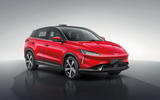Chinese electric car start-up Xpeng will launch in Europe this month as part of a longterm plan to establish itself in the Western EV market.
One hundred examples of its G3 electric crossover will arrive in Norway in December before the company introduces the model to other major EV markets in Europe during 2021.
The G3 is promised to have a WLTP-certified range of 280 miles from a 66kWh battery pack and can charge its battery from 30% to 80% in 30 minutes. It has also been awarded five stars in China’s C-NCAP crash tests. Moreover, the promised price point of around £30,000 for this model would mark out Xpeng as especially competitive.
Xpeng, which sold its first car in 2018 and is now listed on the New York Stock Exchange, currently builds two models on its self-developed EV platform. The G3 and the P7 sports saloon will be joined by two new models in 2021 and 2022.
The firm has developed its own skateboard architecture, called SEPA, which leans heavily on external sensors. It uses 12 ultrasonic radar sensors, eight high-definition cameras and three millimetrewave radar sensors. Xpeng says the car currently has ‘level 2.5’ autonomous driving and self-parking capabilities.
The self-developed vehicle operating system makes significant and regular use of over-the-air software updates, according to Xpeng’s own Chinese-market data from existing customer cars.
Brian Gu, Xpeng’s vice chairman and president, told Autocar the company is prepared to take a long-term view on establishing a domestic Chinese brand in Europe.
“We believe that technology is key in changing people’s perceptions and we note that [Korean] brands such as Samsung and Kia have succeeded,” Gu said. “We also think that the legacy European auto brands might not have the same brand advantages in the market for EVs. We want to build a long-lasting presence. It is not easy to get a strong brand globally, but we are very confident in our product.”
Gu pointed out that the SEPA architecture uses chipsets from global giants Qualcomm and Nvidia, underlining the potential for new types of brand quality in automotive production.
Gu said the G3’s roll-out in Norway – supported by its own staff and engineers – would also be used as the start of research into how Xpeng will retail and support its vehicles in the medium term as the brand seeks to establish itself in the new vehicle market.
READ MORE







Join the debate
Add your comment
Yes it does look somewhat futuristic generic but it's pleasant enough and could be successful as a mass-market EV where badge snobbery doesn't come into play.
I think the EV market suffers from badge snobbery just as much as the ICE market.
It has the 'generic future car' look that should earn it star billing in architect's images of proposed buildings and dystopian movies. Perhaps real life is that dystopian movie now?